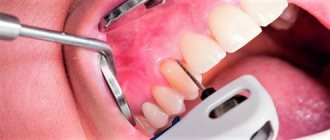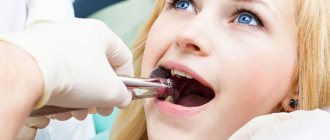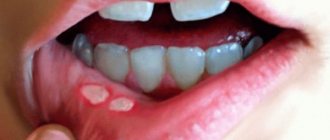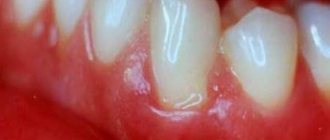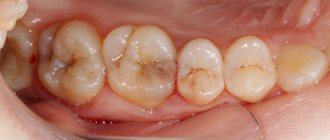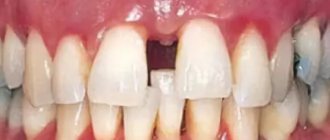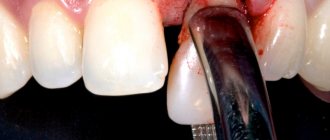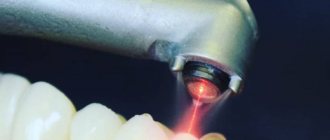5536
Constant pain and discomfort in the lower jaw and temples are the first signs of pathological changes in the temporomandibular joint.
This problem is usually known to people with malocclusions. Unfortunately, it is impossible to eliminate negative symptoms with mouth guards or brace systems without additional treatment.
In such a situation, dentists recommend first performing splint therapy.
The essence of the technique
TMJ dysfunction is a disease of the temporomandibular joint, expressed in pathological changes in the functions of its muscles and ligaments, disruption of the relative position of joint elements and changes in occlusion.
According to statistics, up to 70% of dental patients have some form of TMJ dysfunction. The disease manifests itself as clicking and crunching in the joint, jaw and/or headache, tinnitus, limited jaw mobility (difficulty opening the mouth), bruxism and some other symptoms.
A splint, or otherwise occlusal splint, is a mouthguard made of elastic polymers (silicone, acrylic and other materials). Thanks to its special shape, when worn for a long time, the hypertonicity of the masticatory muscles is relieved, the TMJ ligaments are stretched, and the occlusal load is normalized.
As a result, pathological symptoms disappear - crunching and clicking in the joint, pain, speech impairment, distortion of the facial profile, bruxism.
Splint therapy may be appropriate in the following cases:
- Dysfunction of the temporomandibular joint (TMJ);
- Correction of neuromuscular coordination and movements of the lower jaw;
- Corrective effect on bite;
- For protection and redistribution of load during bruxism.
There are a number of painful conditions (such as, for example, migraines, neck pain, and so on), the origin of which is caused by disturbances in the functioning of the temporomandibular joint. Thus, splint therapy is also associated with the elimination of such conditions.
Types of devices
During manufacturing, the splint is given a configuration that has a therapeutic effect, which depends on the specific clinical picture. Each occlusal splint is individual.
Depending on the functionality, the following types of splints are distinguished:
- Decompression. Designed to relieve muscle hypertonicity, normalize the occlusal load on the teeth, and prevent tooth abrasion. One of the most common pathologies treated with decompression splints is bruxism.
- Relaxation. Relaxes the chewing muscles.
- Positioning. The jaws and dentition are set in a normal occlusal position.
- Replicating . Corrects the position of the jaws relative to each other.
- Stabilizing. The lower jaw is returned to the correct position, in which the condyle moves to the center of the TMJ.
Which plates are most effective for straightening teeth in adults? Come here to find out when the use of the Brückl-Reichenbach apparatus is justified.
At this address https://dr-zubov.ru/ortodontiya/apparaty/trejnery/dlya-ustraneniya-problem-t4a.html we will talk about the use of T4a trainers for the correction of malocclusions in children.
Indications and restrictions
Splint therapy is indicated for the following pathological manifestations:
- discomfort or pain when chewing;
- crunching and clicking when opening/closing the mouth;
- limitation of NP mobility;
- bruxism;
- rapid fatigue of the LF muscles when chewing and talking (manifests mainly at the end of the day);
- headache.
Splints are also used in the diagnosis and treatment of a number of pathologies - periodontal disease, periodontitis, stress syndrome, myofascial syndrome, etc. In some cases, wearing occlusal splints is indicated when installing prostheses and orthodontic devices - as a means of adaptation.
Important. Splint therapy is effective only against TMJ dysfunction, that is, disorders that do not affect the morphological structure of the joint components. Occlusive splints are not intended for the treatment of systemic articular diseases such as arthritis and arthrosis.
A contraindication to splint therapy is inflammation in the RP, as well as pathologies that are caused not by a violation of occlusion, but by some other factors.
Advantages and disadvantages
The advantage of splints is, first of all, the wide range of pathologies for which they are effective. Among them there are those that cannot be cured by any other method other than splint therapy.
Another important advantage of the technology is the reversibility of the changes it produces. There are some ways to correct occlusion in which it is impossible to return to the original situation (for example, grinding the surface of the teeth). Splint therapy is not one of these.
Treatment with occlusal splints does not end with just these two advantages. They are characterized by:
- quick results (pain is relieved almost immediately after the start of treatment).
- ease of use (occlusal aligners are soft, easy to remove and put on, and do not create discomfort even at the very beginning of use).
- Possibility of use in the diagnosis of certain diseases.
The disadvantages of occlusal splints in comparison with their advantages are not significant, but they also occur. Among them:
- the technology is not very widespread in Russia, and as a result, the number of dentists who know splint therapy techniques is small.
- the difficulty of selecting the type of occlusal splint that will be optimal in a particular situation.
- relative duration.
Cost (Moscow) R Cost
| Consultation with a dentist | for free |
Attention! Prices listed on this page may differ from current prices. Check the cost of services at the clinic!
Splint is an occlusal splint that is installed on the teeth. Therapy is aimed at changing muscle tone, their activity, as well as improving the extensibility of the masticatory apparatus, restructuring metabolism and innervation. Thanks to the splint splint, you can correct the functioning of the masticatory apparatus, as well as the structure of the temporomandibular joint, reduce tone, stretch or elongate, stabilize and straighten the disc, and even realign the position of the jaw.
At the Lancet clinic, splints are made individually in a special apparatus - an articulator. The device is adjusted according to the patient's skull parameters and diagnostic models.
A splint splint is a special device, not a prosthesis, designed for comfortable chewing. It can only be installed with the help of a specialist who will monitor its functioning. The cost of the service depends on the complexity of the problem.
Features of split tires:
- not bulky;
- can be removed;
- should only be worn at night and when eating.
Advanced technologies have allowed Lancet clinic specialists to produce splint splints from high-quality, ultra-thin, elastic and durable materials with a memory effect: silicones and polymer plastics.
Manufacturing and installation
The production of occlusal splints involves taking an impression from both jaws, making a plaster mold, wax modeling, and molding a mouth guard.
But before taking impressions, the doctor must determine what type of splint will be needed, that is, accurately diagnose the pathology.
Clinical stage
Diagnostics includes interviewing and examining the patient, establishing an anamnesis, and, if necessary, hardware diagnostics. During the interview and history taking, attention is paid to the following factors:
- time of appearance of the first symptoms of TMJ dysfunction;
- the nature of its manifestation is pain (when chewing and headache), clicking and crunching in the joint, stuffy ears, impaired articulation, fatigue of the jaw muscles when talking and chewing, problems with eating;
- sleep quality;
- intensity of chewing gum use;
- the presence of other diseases - arthritis, arthrosis, osteochondrosis, diseases of the ENT organs, central nervous system disorders, allergic reactions.
- previous orthopedic and orthodontic treatment.
Upon examination it is revealed:
- condition of periodontium, teeth, bite;
- facial asymmetry and poor posture;
- pain on palpation of the TMJ;
- changes in LF movements – decrease in amplitude, limitation of mobility.
Hardware diagnostics
The main means of hardware diagnostics is fluoroscopy of the TMJ to determine the condition of the joint elements. It can be replaced by MRI or CT, which have an advantage over fluoroscopy in the accuracy of the visualized picture of the joint.
Sometimes doctors refer the patient for an immunological blood test, which shows the presence of immunoglobulins in inflammatory processes in the joints.
There may be a need for functional diagnostics (electromyography, arthrophonography, etc.).
Making impressions
The impression is made using standard technology. It is necessary to have a clear imprint of the palate.
Let's find out together how you can straighten teeth without braces for adults and children. In this post, we'll look at the pros and cons of Invisalign aligners.
Here https://dr-zubov.ru/ortodontiya/apparaty/kappy/osobennosti-i-preimushhestva-vyravnivaniya.html we’ll talk about when it is justified to use a mouthguard to straighten teeth.
Laboratory works
In the laboratory, plaster models are made from impressions. Splints can be located on both the upper and lower jaws; the therapeutic effect does not change.
The choice of the jaw on which the occlusal splint is supposed to be installed depends not on its therapeutic functions, but on traditions. North American dentists prefer the lower jaw as the target, European dentists prefer the upper jaw.
If necessary, clasps can be installed on the upper jaw to more reliably stabilize the mouth guard. They are fixed with a self-hardening polymer.
Once fabricated, the models are placed in the articulator and a wax-up is performed. The movement of the jaw in all possible directions is also checked.
The mouthguard is made from sheet polymer by compressing the model on a thermoforming machine. After trimming and cleaning the edges, the occlusal splint is ready to be placed on the patient's teeth.
In the video, a specialist will talk about the intricacies of making splints.
Are splints really a good way to treat TMJ dysfunction? Research Review
Splints as a way to correct the functioning of the muscles and ligaments of the TMJ are used quite often. A group of researchers from Serbia decided to find out whether this method is good in the long term.
It is often quite difficult to determine the etiology of TMJ dysfunction. Splints, occlusal splints, are perceived by many doctors as a universal remedy that alleviates the patient’s condition in most cases. However, randomized controlled trials do not provide the basis for clear conclusions about the justification of using splints.
Serbian researchers conducted a systematic review and meta-analysis of all randomized controlled trials and quasi-randomized trials in Medline, Web of Science, and Embase. Research language - any, publication date - up to 2020.
The main criterion for including a study in the review is that it compares splints and other treatments for TMJ dysfunction. Criteria describing the condition of patients:
- myofascial pain and/or pain in the TMJ;
- myofascial pain and/or pain in the TMJ upon palpation;
- muscle weakness;
- limited movement of the TMJ or deviation in joint movement;
- limited mouth opening with or without reduction;
- clicks and other sounds made by the TMJ;
- headache or ear pain.
From the point of view of alternative methods of treating TMJ dysfunction to splints (Michigan splint, Tanner apparatus, Fox apparatus), the review included studies that included:
- non-occlusive splint;
- occlusal devices;
- physiotherapy;
- behavioral therapy;
- Exercise therapy and group counseling;
- lack of any treatment.
In total, the review included 33 studies, covering 1779 patients, 848 of whom received splints, 931 were control groups. Fifteen studies, involving 1,118 patients, looked at pain, and another subset looked at TMJ dysfunction caused by muscle pathologies.
Analysis of these studies allowed us to draw the following conclusions.
- Stabilization splints significantly reduce pain in the short term (less than 3 months), including pain resulting from muscle dysfunction. Also, in the short term, splints effectively increase muscle tone and the amplitude of mouth opening.
- The stabilization splint is a noticeably more effective treatment method than the non-occlusal splint.
- There is no particular difference in the results of using stabilizing splints and occlusal devices. As the authors note, this means that splints and devices can successfully complement each other in eliminating the symptoms of TMJ dysfunction.
- In the long term (more than 3 months), the use of splints gives results comparable to other types of treatment.
- Splints are noticeably more effective when patients wear them all the time, and not just at night.
- Stabilization splints are a good solution for patients suffering from myogenic dysfunction of the TMJ.
The authors of the study point to the need for more large-scale work of this kind.
If you are removing teeth, but sometimes you are not able to convince the patient not to postpone prosthetics, the dental poster “Why should you put a denture in place of an extracted tooth?” will help you:
(click to enlarge image)
https://lavka.stomanet.ru/product/pochemu-nado-stavit-protez-na-mesto-udalyonnogo-zuba-stomatologicheskij-plakat/
Just hang it on the wall of your office and no further explanation will be required. We send posters throughout Russia at our own expense, that is, delivery is free for you. You can pay from the clinic’s account (non-cash payment for legal entities), as well as by bank card, electronic money.
Are you interested in the details of the research of Serbian colleagues? We can translate the full report for you. The cost of translation is 19,000 rubles. Contact us via this form:
The full text of the study in English can be found at
https://journals.plos.org/plosone/article?id=10.1371/journal.pone.0171296
Share the material with friends and colleagues:
- VK
- by email
- Telegram
Wearing rules and care
The duration of wearing the occlusal splint is determined individually by the dentist. The average treatment period is a month, but sometimes it takes several weeks or months, in rare cases – up to a year or more. To monitor treatment, it is necessary to visit the doctor from time to time, at first more often, then less often.
The occlusal splint must be in the patient's mouth for at least an hour before the dental examination begins. The doctor can adjust the design of the mouthguard by grinding off excess material or adding self-hardening polymer in the right places.
During treatment, the patient must adhere to the following rules.
- The splint is cleaned in the same way as a removable denture - with a brush and toothpaste when removed.
- It is advisable to wear a mouth guard at all times.
- You can’t intentionally squeeze it with your teeth. At rest, there should be a small gap between the upper and lower rows of teeth.
- Splint should be stored in a damp place. A tightly closed container is best suited for this, where it is placed wrapped in a damp cloth.
- If the mouth guard causes severe pain, it should be removed and see a doctor for adjustment.
Splint - splint for teeth
When answering the question of what splint (occlusal therapy) on teeth is, it is necessary to note the following characteristic features:
- A standard or individual dental splint system is a plastic diagnostic or therapeutic and prophylactic overlay on the upper and lower dentition, which changes the usual closure of the teeth.
- The main purpose of any variety of occlusal splint systems is to normalize the functioning of the masticatory apparatus through the treatment of the mandibular muscles and the removal of vertical overload from the jaw joints of the TMJ
- To achieve a sustainable therapeutic effect, the period of wearing a dental splint should be at least 6-9 hours a day, for at least 3-6 months.
In accordance with the above, silicone splints are removable dental aligners for smooth changes in the muscle tone of the masticatory muscles, which are prescribed by osteopaths, gnathologists, orthodontists and neuromuscular dentists for the following diseases:
- TMJ dysfunction
- bruxism
- bite defects
- postural disorders of muscle tone associated with deformities of the spine and neck muscles
Depending on the identified pathology, the specialist prescribes different types of splints:
Chief physician, Salatsky Dmitry Nikolaevich
Sign up for a free consultation
+7
- reduction trays, to change the position of the lower jaw
- decompression splints to relieve pressure on the TMJ articular disc
- positioning aligners for repositioning a displaced TMJ disc
- centering splints to consolidate the achieved treatment results
The therapeutic benefits of splint therapy in orthodontics and neuromuscular dentistry are a controlled and smooth effect on the tone of most of the mandibular muscles, which, coupled with osteopathic correction of the cervical spine and cervical muscles, gives a remarkable clinical effect.
conclusions
- TMJ dysfunction is characterized by complexity of manifestations, making diagnosis difficult. Some symptoms are reminiscent of other diseases that are not related to dental problems. To establish the true picture, it is necessary to use all kinds of diagnostic methods - anamnesis collection, questioning, examination, hardware diagnostics.
- There is currently no fully developed standard technology for splint therapy. Treatment is highly individualized and, to some extent, experimental.
- The use of occlusal splints allows you to effectively correct the functioning of the dentofacial apparatus without producing irreversible effects. Splints are especially effective in combination with other methods of treating dental anomalies.
If you find an error, please select a piece of text and press Ctrl+Enter.
